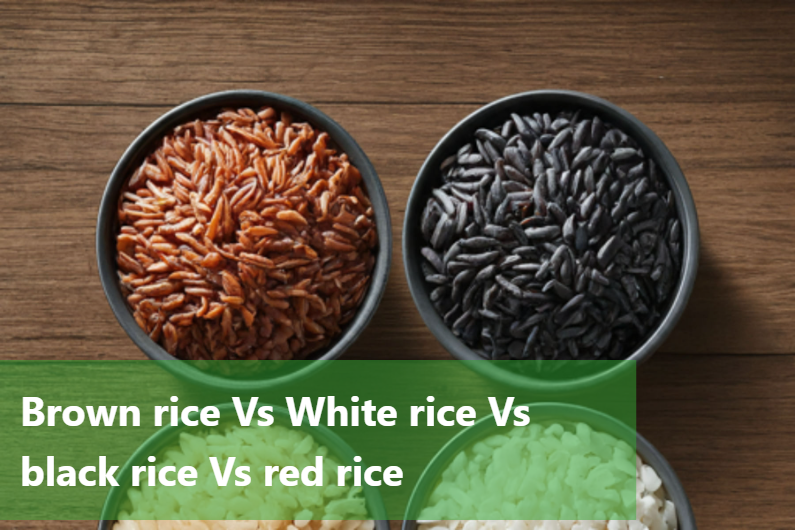Different types of rice:
Rice is a staple food for many cultures worldwide, and it comes in various forms, each with its unique characteristics and nutritional benefits.
Brown Rice: Brown rice is a whole grain that contains the outer bran layer and germ, making it a good source of fiber, vitamins, and minerals. It has a nutty flavor and a chewy texture, and it takes longer to cook than white rice.
White Rice: White rice is the most commonly consumed type of rice. It has been milled to remove the bran and germ, resulting in a lighter texture and faster cooking time. While it is lower in fiber and nutrients compared to brown rice, it is a versatile and easily digestible option.
Black Rice: Black rice, also known as forbidden rice, is a highly nutritious grain that is rich in antioxidants, particularly anthocyanins. It has a slightly sweet flavor and a striking dark color, often used in desserts, rice bowls, and sushi.
Red Rice: Red rice contains a natural red husk with a slightly nutty flavor. It is a good source of iron and antioxidants, and it retains its shape and firmness when cooked, making it a great option for salads and pilafs.
Understanding the distinct characteristics of each type of rice allows for a diverse range of culinary possibilities and nutritional benefits. Whether you are looking for a high-fiber option, antioxidant-rich variety, or simply a versatile staple, the wide spectrum of rice types offers something for everyone.
Nutritional chart of brown rice, white rice, black rice, and red rice
Here's a general nutritional comparison of brown rice, white rice, black rice, and red rice based on a typical serving size of 1 cup (195 grams) of cooked rice:
Brown Rice |
|
|---|---|
Calories |
216 |
Carbohydrates |
45 grams |
Fiber |
3.5 grams |
Protein |
5 grams |
Fat |
1.8 grams |
Magnesium |
21% of the Daily Value (DV) |
Phosphorus |
16% DV |
Thiamin (Vitamin B1) |
12% DV |
Niacin (Vitamin B3) |
15% DV |
|
|
Calories |
206 |
Carbohydrates |
45 grams |
Fiber |
0.6 grams |
Protein |
4.3 grams |
Fat |
0.4 grams |
Magnesium |
4% of DV |
Phosphorus |
6% DV |
Thiamin (Vitamin B1) |
13% DV |
Niacin (Vitamin B3) |
15% DV |
Black Rice |
|
Calories |
160 |
Carbohydrates |
34 grams |
Fiber |
2 grams |
Protein |
5 grams |
Fat |
1.5 grams |
Iron |
5% of DV |
Vitamin E |
4% DV |
Anthocyanins (antioxidants) |
Higher content compared to other varieties |
Red Rice |
|
Calories |
216 |
Carbohydrates |
45 grams |
Fiber |
4 grams |
Protein |
5 grams |
Fat |
1.5 grams |
Iron |
15% of DV |
Zinc |
4% DV |
Manganese |
75% DV |
Magnesium |
15% DV |
These values can vary slightly depending on the brand and cooking method, but they provide a good general overview of the nutritional profiles of each type of rice. It's worth noting that brown, black, and red rice varieties tend to have higher fiber and nutrient content compared to white rice, which has undergone more processing and has the bran and germ removed.
Benefits of including brown, black, and red rice in a diabetes diet
Brown rice is good for diabetes because it has a lot of fiber, which helps with digestion, keeps blood sugar levels in control, and makes you feel full, which can help manage weight.
Black rice, also known as forbidden rice, has powerful antioxidants called anthocyanins. These antioxidants can help with the heart and may reduce the risk of heart disease in people with diabetes.
Red rice has a unique nutty flavor and is rich in compounds like anthocyanins and flavonoids, which give it its deep red color. These things are good for the heart and provide extra antioxidants that can help manage diabetes.
Including these different types of rice in a diabetes diet can bring various health benefits, including better control of blood sugar, support for a healthy heart, and help in maintaining a healthy weight.
To conclude:
As we finish up, it’s clear that adding brown, black, and red rice to a diabetes-friendly diet has lots of benefits. These types of rice are full of fiber, vitamins, and minerals, and they don't raise blood sugar as much as white rice. This makes them good for keeping blood sugar levels steady and staying healthy.
When you eat these rice types, it's important to control how much you eat. Even though they're good for you, it's best to eat them in small amounts to manage the carbs you take in. When you plan your meals, try to include these rice varieties with other healthy foods to make sure your diet is well-balanced.
To sum up, the good nutrients in brown, black, and red rice, along with their diabetes-friendly features, make them great for a balanced diet. If you control your portions and plan your meals carefully, you can enjoy the benefits of these rice varieties as part of a healthy lifestyle.
Say GOODBYE to restrictions on Rice during Diabetes. Introducing Low GI Rice from DiabeSmart - India's 1st Diabetes Foods Brand
✅Helps Manage Blood Sugar Levels
✅Clinically Tested: GI < 55
✅Cooks & Tastes like Regular White Rice
✅Good for Whole Family
References
This Blog post is an initiative by DiabeSmart, to provide accurate and Nutritionist / Doctor approved information related to Diabetes. DiabeSmart is India's first Food brand designed specifically for Diabetics, that has been clinically tested on Diabetics and Pre-Diabetics to deliver 55% - 70% lower Sugar spikes. DiabeSmart is part of Lo! Foods - India's leading brand for Everyday Functional Health foods.











